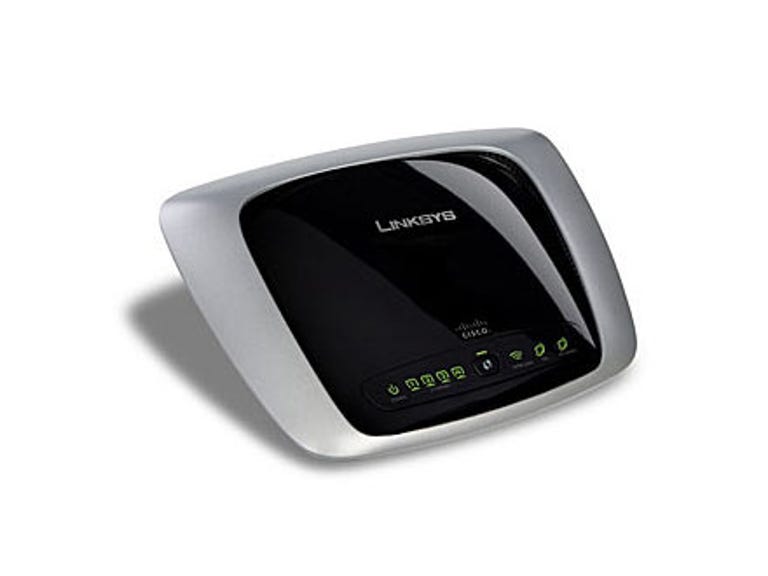 Why You Can Trust CNET
Why You Can Trust CNET Linksys WAG160N review: Linksys WAG160N Wireless-N ADSL2+ Gateway
Linksys' WAG160N resides in an attractive package, and manages better than most Wireless N routers. Better than most, but still nowhere near the hype.
Design
The WAG160N shares Linksys' new design philosophy (also seen on the WRT310N), which is to make smaller, more discrete Wireless-N devices without the multiple external antennae and a sleek design that wouldn't look out of place on the deck of the Starship Enterprise. Out the back of the WAG160N it's very much business as usual however, with four 10/100 Ethernet ports, a red reset button and a DSL input socket.
The Good
The Bad
The Bottom Line
In accordance with Linksys' long-standing policy for routers, the first thing that drops out of the packaging when you open the box is a large blue folder with a CD-based installation utility on board. We've not been a big fan of Linksys' CD-based installers in the past, finding many of them incompatible with Australian ISP settings, but with the introduction of Linksys' LELA (Linksys EasyLink Advisor) package, our opinion has changed. More on LELA later. LELA is Windows (XP/Vista) and Mac OS X (10.4 or better) compatible.
The setup routine itself is well laid out and animated, and includes pre-configured settings for iiNet, Internode, Optus, Soul, Telstra and TPG. If you're with an alternate ISP, you'll need to enter most of your settings manually.
Features
The WAG160N's big selling point is the inclusion of Wireless N Draft 2.0 compatibility, although to Linksys' credit, they don't plaster the outside packaging with lots of claims of 300mbps connection speed. The back of the box does have a silly speed graph comparing 802.11g and Wireless N, but even there numbers are omitted. Something tells us that perhaps networking companies are waking up and dumping the hype cycle around 802.11n.
The WAG160N is also an ADSL2+ router. Some users love all-in devices for their simplicity, although the flip side of that is that you're setting up a single failure point in your network. As with most home routers, wireless security (WEP, WPA2 Personal and Enterprise) is supported, along with QoS settings for applications and UPnP. It also supports WiFi Protected setup if you have compatible adaptors.
Performance
Using LELA to set up the WAG160N was a suitably painless process, and we tested with both Windows and Mac boxes, just to spot if there were any particular differences. There's one big difference, and it's one that's not made terribly clear on the packaging. LELA comprises two components; an initial setup wizard that's not terribly dissimilar to the wizards Linksys has used in the past, and a network monitoring tool that identifies the elements of your wired and wireless network. Windows users get both parts of the package, but the Mac world has to make do with only the setup wizard.
As a network monitoring application, LELA works suitably well for networking novices, providing a simple network map of your connected devices. We'd argue that Network Magic Pro is a better application than LELA, especially as we had to do some tweaking around the edges to help LELA identify some of our connected systems properly, something we've not had to do with Network Magic Pro, or even the free version of Network Magic.
On the performance front, we took the WAG160N through the same set of tests we've used for 802.11n routers recently, testing for signal strength and throughput. There is an obvious problem with wireless testing, in that it can vary widely depending on your network circumstances, and your results may vary from ours.
| Distance from router | Linksys WAG160N | Billion BiPAC 7300N | Conceptronic 300Mbs | Linksys WRT160N |
| 5m | 70% | 75% | 92% | 80% |
| 15m (minor walls) | 53% | 59% | 62% | 62% |
| 15m (multiple walls) | 48% | 54% | 60% | 50% |
On the signal front, the WAG160N didn't fare particularly well; even up against the WRT160N it struggled once the going got tough. For smaller domestic residences, that's probably enough signal, but if you know you're in a wireless blackspot, or live in a larger house, it may spell wireless doom.
| Distance between PCs | Linksys WAG160N | Billion BiPAC 7300N | Conceptronic 300Mbs | Linksys WRT160N |
| 2m, no barriers | 19.8Mbps | 21Mbps | 15Mbps | 4.88Mbps |
| 20m, multiple walls | 15.2Mbps | 13.3Mbps | 7.7Mbps | 10.12Mbps |
On the wireless data throughput test, however, the WAG160N acquitted itself beautifully. While its close testing figure wasn't the fastest we've seen, with some distance and walls between it managed to pump more data through than any other router we've tested.
The WAG160N has a fair amount going for it. The AU$199 asking price is fair value (although you may need to fork out extra for wireless N adaptors to go with it), the data throughput is better than most, and the design means it's no longer a router that you'd need to hide away. At the same time, we can't help but feel deflated that, once again, Wireless N doesn't prove to be the speed demon that all the networking companies insist it is.



